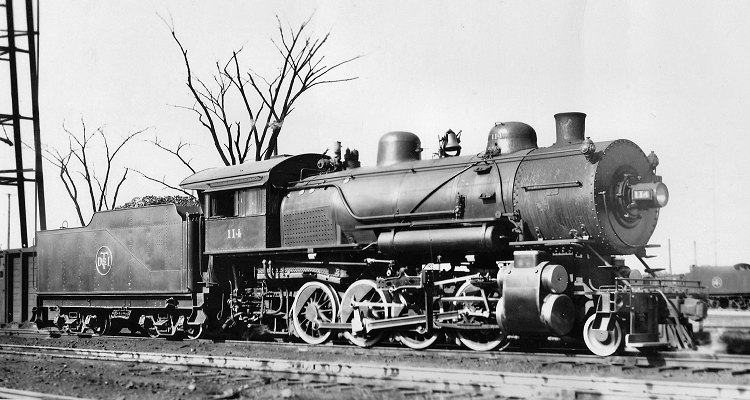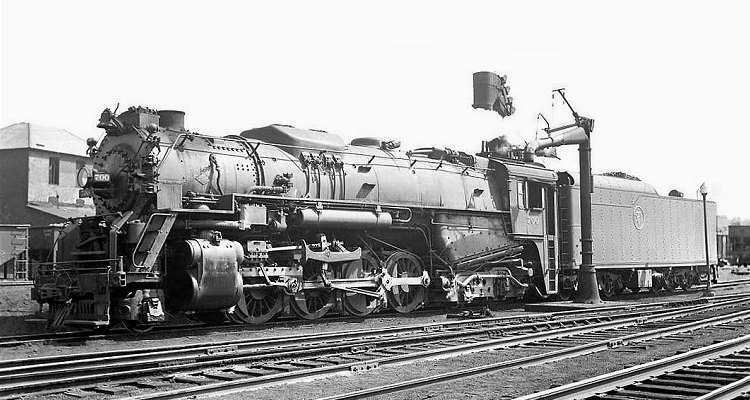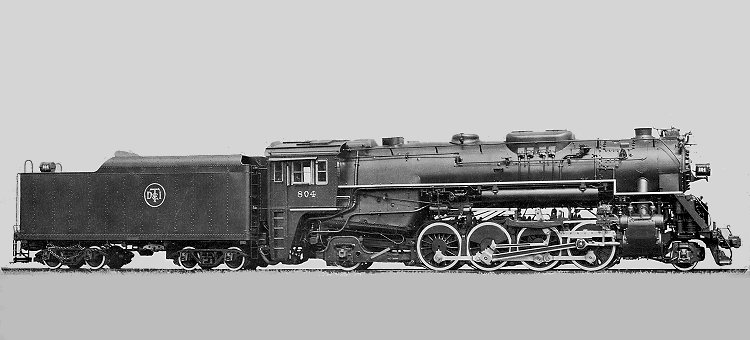
Ex-Southern Pacific FP7s in Amtrak Phase 1. SP required their old FP7s on the lead of any train crossing Donner Pass, because SP had equipped their FP7s with icicle breakers to keep dome cars from getting damaged

A certain someone who holds a certain position who I neither agree or disagree with nor voted for or did not vote for (was that vague enough to avoid trouble with moderators?) gets off a Metroliner still lettered for Penn Central

I've never seen or heard of a Boynton locomotive. Only 4ft. wide, supported by an overhead rail. (circa. 1890 Coney Island)


In reply to 914Driver :
I'd seen an old 1890s era drawing of that thing but I just assumed it was some flight of fancy. I never knew they actually built one
The ultimate freakshow was the Holman Locomotive Speeding Truck Company locomotive. Essentially a conventional 4-4-0, it then had 2 sets of roller trucks underneath the axles, technically making it a 6-12-0. There was no gear reduction and the supposed advantage was that it increased the locomotive's speed, though no explanation for how it did so was ever given. One locomotive was constructed by Baldwin in 1887 and it was immediately ridiculed by anyone with any railroad industry knowledge. In fact, Holman Locomotive Speeding Truck Company had no intention of actually building or marketing these things. They did make a few runs with it, but the whole affair was all a scam to get money out of investors who didn't know any better, and then the company founders took off with the money. What happened to this locomotive is unknown.
Then, ten years later, in 1897, Baldwin built yet another locomotive on the Holman principle, this one without the idlers under the lead truck, so it was a 4-12-0. To convince new investors this time, they presented a patent filed May 7, 1897. Again, tt briefly operated on the South Jersey Railway. The company must have believed that people forgot their scam and would fall for it again. And they clearly had, because it worked again. The locomotive was then returned to Baldwin soon after where it was rebuilt to a traditional 4-4-0 design and sold to Kansas City and Northern Connecting Railroad.
No further Holman locomotives were constructed.
Spent the weekend playing at Mid-Ohio. Then took a detour through the Amish countryside in Holmes County Ohio.
Found what must be one of NickD's five favorite places in the U.S. of A.
What a roundhouse and collection! Somewhere south of Sugar Creek Ohio...
Everything looks so new. It really needs the patina of smoke, grime, and ciders. ![]() It's like a brand new train set right out of the box. Way impressive place.
It's like a brand new train set right out of the box. Way impressive place.

During the 1920s, Henry Ford once owned a railroad, the Detroit, Toledo & Ironton.
Founded in 1901 from the merger of the bankrupt Detroit & Lima Northern Railway and the also-bankrupt Ohio Southern Railway, the DT&I began its life as a combination of narrow gauge lines that squiggled their way across western Ohio and into Michigan. Eventually regauged to standard gauge, it acquired other bankrupt lines, eventually stretching from Detroit to Ironton, via Toledo. Described as "a wavering streak of rust" or a "line from nowhere to nowhere", the DT&I suffered from a meandering right-of-way, crumbling infrastructure, feeble finances, obsolete equipment and poor management and was the butt of frequent industry jokes.
Enter Henry Ford. In 1920, the Rouge River was being dredge so that Ford's fleet of lake freighters could sail up the river and dock at the Ford Motor Company's Rouge Plant. The new shipping plan required the re-engineering of all the railroad bridges, including the DT&I's. The DT&I cried poverty (they had just gone bankrupt again in 1908) and said they couldn't afford to spend the $350,000 to build a new drawbridge. DT&I approached Henry Ford about helping them to replace the bridge, since he was the one requiring it's construction and instead Ford slapped down $5 million and purchased the entire DT&I.
The DT&I may have been a disaster and it may have gone from nowhere to nowhere, but Ford saw potential in the fact that it crossed paths with pretty much every major railroad in western Ohio. He was in his vertical integration mindset and envisioned it as a highway funneling supplies into the Rouge River plant and then hauling away complete cars to be interchanged onto other railroads. And so, Henry Ford immediately sank $15 million into the DT&I making improvements. Cutoffs were constructed, shortening the overall route by 60 miles. Grades were knocked down to make the system as flat as possible. The entire line was relaid with heavier rail imported from Belgium. Central traffic control and automated signals were installed. The freight-heavy Detroit area lines were fully double-tracked. Gas-electric doodlebugs were purchased for the Bainbridge-Detroit daily passenger runs. Numerous grade crossings were eliminated by converting the tracks to overpass. Where grade crossings couldn't be removed, automated crossing guard signals were installed. Train crews were paid higher amounts to encourage them to take better care of the equipment. The DT&I went from being the punchline of jokes to a modern, efficient railroad that was the envy of the industry, although critics were quick to point out that the railroad's prosperity only came because of Ford's involvement and without the factory, it would be nothing. But operating ratios were some of the lowest in the country and the DT&I turned massive profits every year, except for 1927 when Ford shut down the factory for the conversion from Model T to Model A production.
Henry Ford's influences were found everywhere. Most of the DT&I management was dismissed and not replaced. The unions and the Brotherhood of Locomotive Engineers were shown the door. Crews were encouraged to spend any down time that they had cleaning the locomotives (They also briefly were required to wear all-white coveralls). Rather than painted-on numbers and heralds, the locomotives instead were given nickel-plated letters and numbers made of embossed tin, riveted to the cabs, domes and tenders. They also had all the iron piping replaced with polished copper, the running boards and wheels were striped in white, and Russian iron boiler jacketing installed. Henry Ford frequently rode along in the cabs of locomotives and would take the throttle for spells, and would also come down and talk with the engine crews regularly.
![]()

Ford had even further goals for the DT&I, and began rolling out an ambitious three-part plan. The first part was that he decided to electrify the entirety of the DT&I, all 400+ miles of it. Electric locomotives had already been proven to be very efficient, and Ford had an advantage in that he had his own power plant at the Rouge River facility, so he had a source of cheap electricity. He predicted that the excess generating capacity would be enough to operate the whole system. The second part of the plan was that he wanted to build an extension from Ironton down to Deepwater, West Virginia, where it would interchange with the Virginian. That would allow Ford to haul coal from the Virginian's end of the line, rather than wait for the C&O or PRR or N&W to bring the coal up to their interchanges. The final step of the plan was for him to purchase the Virginian and merge the VGN and the DT&I. Since the VGN also had an electrified mainline, it would allow him to combine the systems and haul from Detroit to Norfolk entirely under the wires, cut VGN out as a middleman in the coal-hauling operations, and provide Ford with Atlantic ports at Norfolk.
Electrification on the DT&I was first started in 1926 between Dearborn and Flat Rock. Ford said that he wanted the infrastructure to "last indefinitely" and so rather than use wooden poles or steel girders to hang the catenary, they used 7.5 ton cast concrete arches over the track. Two 3800hp D-D+D-D electric boxcabs were constructed at Ford's Highland Park facility and put into service between the River Rouge facility and the Flat Rock yard. These, and some 0-8-0 switchers, were the only new locomotives purchased under Ford, which meant that those massive profits and wild efficiency were generated using a handful of ancient 4-4-0s, old Ten-Wheelers, castoff Russian Decapods and some 2-8-0s purchased shortly after the 1908 bankruptcy.

Unfortunately, Ford's plans never went any further. Additional pedestals for the concrete arches were constructed southwest of Flat Rock, all the way to Maybee, but never had arches installed. It quickly became apparent that the excess generating capacity at Rouge River was not going to be enough to power the entire system. Another issue to the electrification was that the DT&I was running 22 kV 25 Hz AC, which was the the wrong voltage for interoperable equipment, as the Virginian electrified at 11 kV AC. So there was no sense to the electrifying further, only to have to extensively re-engineer at either end. The extension to Deepwater so that it could interchange with the VGN was also never constructed. Presumably, the ICC blocked this, as Ford and the ICC began to butt heads more and more, but perhaps the electric plan falling through made it not quite as attractive. And because the extension was never constructed, Ford never made a move to purchase the VGN.
In 1929, Henry Ford put the Detroit, Toledo & Ironton up for sale and sold it to the Pennsylvania Railroad for around $35 million. By that point he had basically realized that the ICC was never going to allow him to run the railroad the way that he wanted, and if he couldn't run it how he wanted, he didn't want to run it all. Other people also theorize that with the beginning of airplane production and the acquisition of the rubber plantation in Brazil and several other ventures, Ford just lost interest in the railroad. After the DT&I's sale, Ford never dabbled in railroads again.
Some of his influences remained with the DT&I after its sale to the PRR. The PRR scrapped the electric locomotives and removed the wires in 1930, finding the short-distance electrification to be pointless, but the concrete catenary arches were too expensive to remove and many of them still exist to this day. Also, subsequent steam locomotive purchases maintained the tradition of nickel-plated, embossed tin heralds and numbers on the cabs and tenders.

After sale to PRR, the DT&I did buy its first new steam locomotives, and they took an odd development turn.
The main power for the DT&I was a series of 2-8-0s, purchased between its 1908 bankruptcy and 1912 from Alco's Brooks works.

After Ford sold the Detroit, Toledo & Ironton to Pennsylvania Railroad in '29, it became apparent that newer, more powerful steam locomotives would be necessary to keep up with business (perhaps another reason Ford sold out, he didn't want to invest in new power). They skipped the 2-8-2 and instead purchased six 2-8-4s from Lima between 1935 and 1939. These were not fast freight engines, they were more like the IC or C&NW or Boston & Albany Berkshires, with 63" drivers. They were relatively small and light but were decades more modern than anything on the DT&I, with stokers and all-weather cabs. There were problems with the design, at least as far as their service on the DT&I was concerned. The railroad was too narrow in places and much of the right of way had badly conditioned ties by this point. Also the four-wheel Commonwealth trailer truck proved troublesome in yard switching duty with its high axle loadings, and the large twelve wheel tender was a problem on light rails of passing sidings and yard trackage. The verdict on the all-weather cabs split down a seasonal divide: in the winter they were great, but in the summer, crewmen would open all the doors and windows and even wore an extra set of coveralls to protect them from the intense heat in the cabs.

The Berkshires were determined to be a bit too much for the DT&I, and so when they returned for even more power in 1940, they purchased four 2-8-2s from Lima and another four in 1944. They still had that all-weather cabs but smaller 8-wheel tenders, smaller cylinders and a single-axle trailing truck with a correspondingly smaller firebox made them the Goldilocks of the DT&I. That makes the DT&I unique in that it was the only railroad to make the backward progression of purchasing 2-8-2s after 2-8-4s.

A collection of DT&I steam power arrayed around the turntable in 1954. The engine all the way to the left is one of the old Consolidations, while the engine next to it is a PRR H10s Consolidation. After PRR took ownership, H10ss were frequent visitors and several older PRR Atlantics were also moved up there to handle passenger runs.

Purple Frog (Forum Supporter) said:Spent the weekend playing at Mid-Ohio. Then took a detour through the Amish countryside in Holmes County Ohio.
Found what must be one of NickD's five favorite places in the U.S. of A.
What a roundhouse and collection! Somewhere south of Sugar Creek Ohio...
Everything looks so new. It really needs the patina of smoke, grime, and ciders.
It's like a brand new train set right out of the box. Way impressive place.
I'd like to get out there eventually, although I am admittedly still a little baffled on what their long-term plan is. When Jerry Jacobson owned the Ohio Central, he could run the steam locomotives he owned over the Ohio Central on excursions. But he sold the Ohio Central to fund the construction of Age of Steam, and then Genesee & Wyoming (who bought the Ohio Central) wouldn't let him run excursions over it. So now they have all this equipment and keep buying more and restoring it to operation but don't have anywhere to operate it other than their yard. And originally it wasn't even open to the public. Its only in the past few years that they've started letting people in, and even then it's not everyday like Steamtown or Railroad Museum of Pennsylvania.
You'll need to log in to post.